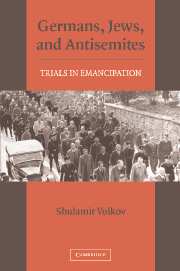Epilogue: Closing the Circle
Published online by Cambridge University Press: 05 June 2012
Summary
Two general works on the Jews during the Weimar Republic have been published during the last decade of the twentieth century. One is Michael Brenner's book, The Renaissance of Jewish Culture in Weimar Germany, and the other – a history of German Jewry from the eve of World War I to 1945, written by Moshe Zimmermann. They clearly represent two diametrically opposed views. Zimmermann looks at German Jews on the eve of the Nazis' rise to power and sees a disintegrating community whose members are losing interest in being associated with it and instead opt for secular life that is undistinguished from the rest of Germany's new civil society. In Zimmermann's book, German Jewry thus continued the process of radical assimilation that had characterized it for generations, increasingly neglecting old identities while fully adopting new ones. If conversion never became a mass movement, most Jews showed no more interest in their religious and communal ties now, becoming “ordinary Germans.” In addition, a variety of demographic indicators pointed out to the process of their disappearance. They were now marrying non-Jews in growing numbers, their birth and death rates had plummeted, they were becoming a smaller and an increasing elderly community. Contemporaries, too, runs the argument, were engaged in describing the “Decline of German Jewry,” arguing its pro and cons. Despite the massive immigration from the east following World War I, the German Jewish community seemed to be shrinking – both physically and spiritually.
- Type
- Chapter
- Information
- Germans, Jews, and AntisemitesTrials in Emancipation, pp. 287 - 298Publisher: Cambridge University PressPrint publication year: 2006



